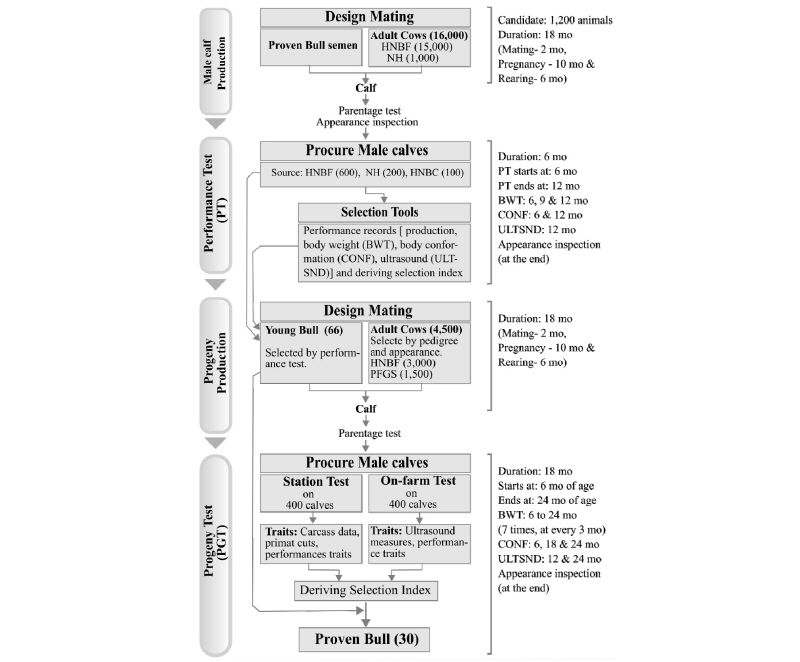Abstract
Korean Hanwoo cattle is the most appreciated cattle in the Korean peninsula. A greater attention on their systematic breeding was observed only a few decades ago, especially after they showed more promises through purebreeding. Although, Hanwoo cattle population (~2.67 million) are widespread throughout Korea, two provinces (Gyeongbuk and Jeonnam) are found most abundant. Four varieties of Hanwoo such as brown, brindle, black and Jeju black are present in the population of which brown coated cattle comprises the majority and most preferred for Hanwoo breeding programs. It is found that all available genetic variants other than brown coated cattle are under great threat of extinction as there is no planned breeding programs for them. Although other variants are ignored, the mainstream Hanwoo development (with brown cattle) has achieved significant improvement over past six decades because of systematic breeding policies. In this study, Hanwoo farms are shown into four categories based on their production scales (type A [1 to 19 cattle], type B [20 to 49 cattle], type C [50 to 99 cattle], and type D [100 cattle and more]). The type A farms are reduced by 15 folds, whereas type B, C or D farms are increased by 5 to 28 folds since 1985. These significant changes also caused shortage in calf production for largerscale farms in recent years. The proportions of cow-calf, feedlot, and composite farms are found to be as 45%, 5%, and 50%, respectively. Few major agencies (Ministry of Agriculture and Forestry, National Institute of Animal Science, Hanwoo Improvement Center, Korea Animal Improvement Association, Korea Institute for Animal Products Quality Evaluation) performed distinct roles for Hanwoo development. The “Hanwoo Improvement Complex”, “Hanwoo Improvement Farm”, “Hanwoo proven bull selection”, “Hanwoo nucleus breeding farm”, and “progressive farmers’ group support program” are shown as major breeding initiatives undertaken by different agencies. Increasing efficiency in breeding programs (by selecting best mates for females and minimize inbreeding rate) through proven bull selection program is ongoing for few decades. For proven bull selection, a performance test first selects candidate bulls, between 6 to 12 mo of age, for next phase (progeny testing) of the program. Sixty young bulls selected through performance tests are design mated with 4,500 adult cows, from which 800 male calves are selected for progeny tests. Semen produced from proven bulls are disseminated across the country. With respect to carcass grading, meat quality (9 grades) are primarily based on marbling scores than other grading criteria. This review study attempted to provide a comprehensive detail on most of these breeding initiatives as those programs were developed according to breeding goals to assist farmers and animal breeders for efficient utilization of genetic resources. We believe that this study would be a significant resource for future references as well.
Acknowledgements
This research was supported by the funding from the project “Development of Estimation Model for Hanwoo Breeding Value and Accuracy Improvement of Genetic Merit Evaluation (Project No: PJ01260602)” and the “RDA Research Associate Fellowship Program” of the National Institute of Animal Science, Cheonan, Korea.
Figures & Tables

Flow diagram of Hanwoo proven bull selection program in 2017 (HNBF, Hanwoo Nucleus Breeding Farm; NH, NongHyup; HNBC, Hanwoo Nucleus Breeding Center; BWT; CONF; ULTSND; PFGS, progressive farmers’ support group).


